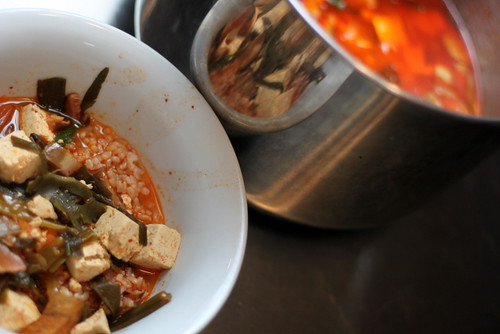I have now taken kimchi to a whole new level. Kimchi stew. This is a whole meal built around kimchi. I’d had it twice before. Once at the food court at the HMART, where it was such a bold tasting surprise, I was knocked over. I had not expected such as powerful, hearty, vibrant dish from the lowly-seeming and humble kimchi. The soup came bubbling hot in the ceramic pot. It was so hot (temperature wise) that I could only bravely sip at the spoon before retreating because it was so hot. Do not give up. Do not give up.
You serve it over rice, and the rice soaks up all the nice bubbling scarlet broth. It cools off a bit, and you can put whole spoonfuls in your mouth. As it sits, the flavors meld, and as the heat eases, you can really taste what’s going on. (This is true with most soups and stews by the way. They're rarely at their best when piping hot -- the flavor comes through as it cools.)
Then I had it at the neighborhood Korean restaurant. This time it had pork in it. And it was an indescribable encore. I feel cheated that I had not been introduced to it before. So, two experiences with Kimchi stew.
With Bradford off to school, I’m the only one that’s eating the kimchi. And there’s still a have a large jar in the fridge, past it’s “best by” date. All that I’ve read about kimchi says that as it ages, it changes, but at some point, it ferments over the edge. So what people do is make kimchi stew with the “ripe” kimchi.
I was all set. I even had some soft tofu in the fridge, which according to the tofu packages (of which there are many at the HMART) is the kind of tofu to use for stews. And some shitake mushrooms and seaweed. I’d perused some recipes online, and realized an inspiring thing. All the recipes for kimchi were different. Significantly so. They all used kimchi. Some used pork, pork belly, canned tuna, spam for extra flavoring. Some used chicken broth. Some just water. Lots of water. Less water. Onions. Garlic. That sort of thing. I realized that there was no one right recipe. Which left tons of room for interpretation and experimentation. My kind of dish.
I settled on this recipe from Womens Health magazine as a good starting point. And went from there. It called for just the right amount of kimchi that I had, just the right amount of tofu, and even eggplant, of which I happend to have a few beautiful specimens of in my fridge. It was a sign.
Kimchi Stew
1.5 oz dried shiitake mushrooms
1/2 oz dried kelp
2 tsp vegetable oil
10 oz kimchi, chopped
2 garlic cloves, minced
350 grams firm tofu, cubed (OK...this was one package)
3 green onions, white and green parts, sliced -- I left these out, because my kimchi was green onion kimchi.
1 small eggplant, cubed
1 Tbsp soybean paste (doenjang) I didn't think I had any but later realized this is probably miso, which I have plenty of. I did have some crab paste though, and I used that instead. That, plus some dried shrimp gave it a nice, deep flavor.
3 TBSP crab paste
Dried shrimp, to garnish.
4 cups of water (not 6, per the recipe)
I fried the garlic and kimchi for a few minutes, then added the tofu, eggplant and shitakes and kelp, and cooked for about five minutes together while I boiled four cups of water. When the water was ready, I added it, and let it simmer for about ten minutes. I added the crab paste toward the end.
In the meantime, I readied a bowl of plain brown rice to receive the experiment.
As with my restaurant experiences, the stew was too hot to eat right away. I needed some time to cool. But this is when I decided it needed a little more help. First, I added another tablespoon of the crab paste, right to the bowl I was eating out of. Then, a sprinkle of dried shrimp. These are an incredible condiment to have around. The finishing touch was a light splash of soy sauce. A quick splash. A few drops, really. They were just the extra umami to put this over the top. It had the complexity of flavor I was looking for, that got better as the ingredients interacted with each other. The eggplant especially, and the tofu to some extent, soaked up the flavor of that pungent deep red broth.
Fast forward a week, then two weeks, and more. More experimentation. I found that using stock is good. No surprise. I'd had some chicken stock frozen from the last time we had one of those rotisserie chickens from the grocery.
Pork belly was a terrific addition. HMART has a whole case of pork belly sliced in different widths. I'd never cooked with pork belly before. It's basically bacon without the curing. I used perhaps an eighth of a pound. Diced. Fried it up with the garlic and other veggies right at the beginning. It gives the stew a nice depth of flavor.
Then, I'd seen some recipes calling for a can of tuna. So I tried that, and surprisingly that was terrific too. I've seen spam mentioned as well -- I haven't tried that yet though.
The stew keeps. It's filling and tasty. And much smoother -- that's the best word I can come up with -- than raw kimchi. The cooking takes the edge off. It's spicy, yes, but not overwhelming. Some might be tempted to add spice to it. So, even if you're repelled by raw kimchi, give kimchi stew a try. You'll be surprised.
Here's the complete series of articles on kimchi:
Enough kimchi for a lifetime of exploration kimchi stew kimchi pancakes (stay tuned!) and this extra article on the kimchi crisis in Korea






No comments:
Post a Comment